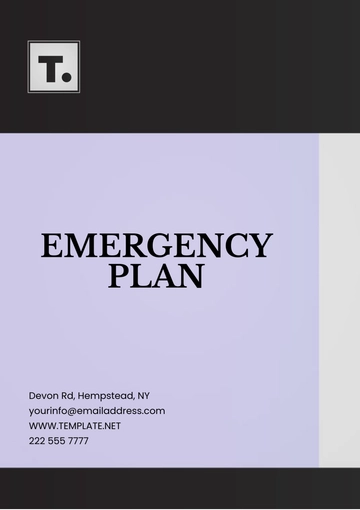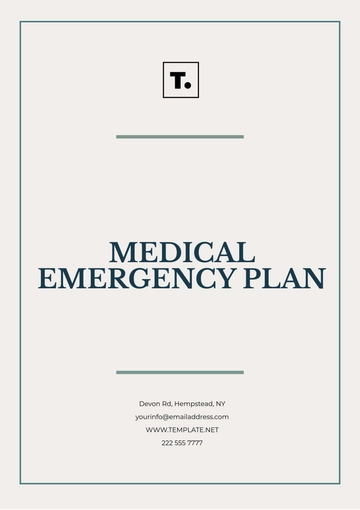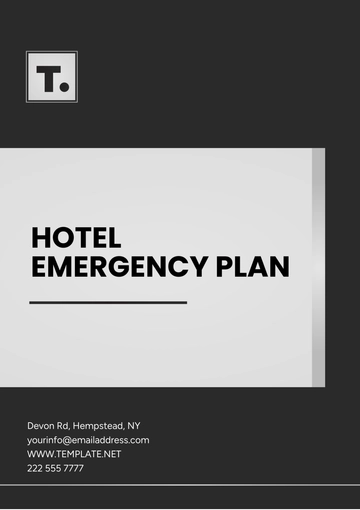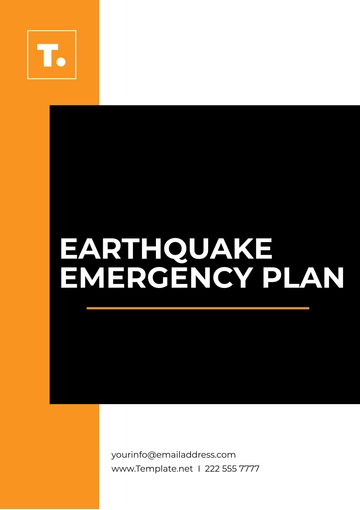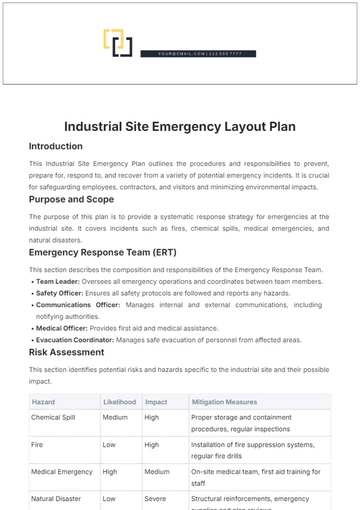Free Industrial Site Emergency Layout Plan

Introduction
This Industrial Site Emergency Plan outlines the procedures and responsibilities to prevent, prepare for, respond to, and recover from a variety of potential emergency incidents. It is crucial for safeguarding employees, contractors, and visitors and minimizing environmental impacts.
Purpose and Scope
The purpose of this plan is to provide a systematic response strategy for emergencies at the industrial site. It covers incidents such as fires, chemical spills, medical emergencies, and natural disasters.
Emergency Response Team (ERT)
This section describes the composition and responsibilities of the Emergency Response Team.
Team Leader: Oversees all emergency operations and coordinates between team members.
Safety Officer: Ensures all safety protocols are followed and reports any hazards.
Communications Officer: Manages internal and external communications, including notifying authorities.
Medical Officer: Provides first aid and medical assistance.
Evacuation Coordinator: Manages safe evacuation of personnel from affected areas.
Risk Assessment
This section identifies potential risks and hazards specific to the industrial site and their possible impact.
Hazard | Likelihood | Impact | Mitigation Measures |
|---|---|---|---|
Chemical Spill | Medium | High | Proper storage and containment procedures, regular inspections |
Fire | Low | High | Installation of fire suppression systems, regular fire drills |
Medical Emergency | High | Medium | On-site medical team, first aid training for staff |
Natural Disaster | Low | Severe | Structural reinforcements, emergency supplies and plan reviews |
Emergency Procedures
Outlined emergency procedures for different scenarios.
Fire
Activate fire alarm systems immediately.
Evacuate the area using the nearest exit.
Assemble at designated muster points.
Contact the fire department.
Do not return to the evacuated area until it is declared safe.
Chemical Spill
Alert personnel of the spill immediately.
Evacuate affected areas if needed, using suggested routes.
Contain the spill using absorbent materials if safe to do so.
Notify the Environmental Officer for cleanup operations.
Medical Emergency
Report the emergency to the Medical Officer immediately.
Provide first aid to the injured person if trained.
Call emergency medical services if required.
Document the incident for follow-up investigations.
Communication Plan
An effective communication plan is essential during an emergency.
Establish clear communication lines with first responders.
Ensure all personnel are aware of and trained in using communication devices.
Regularly test communication equipment for reliability.
Maintain an updated list of emergency contacts including local authorities.
Training and Drills
Regular training and drills ensure preparedness and efficient response.
Conduct semi-annual fire and evacuation drills.
First aid and CPR training sessions biannually.
Invite experts for emergency response workshops.
Regular review and updates of emergency procedures.
Recovery and Review
Post-incident recovery and review procedures for continuous improvement.
Conduct a debriefing session with all ERT members post-incident.
Assess the effectiveness of the response and identify areas for improvement.
Update and modify the emergency plan based on findings and recommendations.
Maintain clear documentation of the incident and response for legal and regulatory purposes.
- 100% Customizable, free editor
- Access 1 Million+ Templates, photo’s & graphics
- Download or share as a template
- Click and replace photos, graphics, text, backgrounds
- Resize, crop, AI write & more
- Access advanced editor
Enhance safety and preparedness with the Industrial Site Emergency Layout Plan Template. This customizable and downloadable template allows you to create a detailed layout for emergency response plans tailored to your specific industrial site. It's easily editable in our AI Editor Tool, ensuring your plans are up-to-date and effective. Plus, it's printable for quick access in any situation.
You may also like
- Finance Plan
- Construction Plan
- Sales Plan
- Development Plan
- Career Plan
- Budget Plan
- HR Plan
- Education Plan
- Transition Plan
- Work Plan
- Training Plan
- Communication Plan
- Operation Plan
- Health And Safety Plan
- Strategy Plan
- Professional Development Plan
- Advertising Plan
- Risk Management Plan
- Restaurant Plan
- School Plan
- Nursing Home Patient Care Plan
- Nursing Care Plan
- Plan Event
- Startup Plan
- Social Media Plan
- Staffing Plan
- Annual Plan
- Content Plan
- Payment Plan
- Implementation Plan
- Hotel Plan
- Workout Plan
- Accounting Plan
- Campaign Plan
- Essay Plan
- 30 60 90 Day Plan
- Research Plan
- Recruitment Plan
- 90 Day Plan
- Quarterly Plan
- Emergency Plan
- 5 Year Plan
- Gym Plan
- Personal Plan
- IT and Software Plan
- Treatment Plan
- Real Estate Plan
- Law Firm Plan
- Healthcare Plan
- Improvement Plan
- Media Plan
- 5 Year Business Plan
- Learning Plan
- Marketing Campaign Plan
- Travel Agency Plan
- Cleaning Services Plan
- Interior Design Plan
- Performance Plan
- PR Plan
- Birth Plan
- Life Plan
- SEO Plan
- Disaster Recovery Plan
- Continuity Plan
- Launch Plan
- Legal Plan
- Behavior Plan
- Performance Improvement Plan
- Salon Plan
- Security Plan
- Security Management Plan
- Employee Development Plan
- Quality Plan
- Service Improvement Plan
- Growth Plan
- Incident Response Plan
- Basketball Plan
- Emergency Action Plan
- Product Launch Plan
- Spa Plan
- Employee Training Plan
- Data Analysis Plan
- Employee Action Plan
- Territory Plan
- Audit Plan
- Classroom Plan
- Activity Plan
- Parenting Plan
- Care Plan
- Project Execution Plan
- Exercise Plan
- Internship Plan
- Software Development Plan
- Continuous Improvement Plan
- Leave Plan
- 90 Day Sales Plan
- Advertising Agency Plan
- Employee Transition Plan
- Smart Action Plan
- Workplace Safety Plan
- Behavior Change Plan
- Contingency Plan
- Continuity of Operations Plan
- Health Plan
- Quality Control Plan
- Self Plan
- Sports Development Plan
- Change Management Plan
- Ecommerce Plan
- Personal Financial Plan
- Process Improvement Plan
- 30-60-90 Day Sales Plan
- Crisis Management Plan
- Engagement Plan
- Execution Plan
- Pandemic Plan
- Quality Assurance Plan
- Service Continuity Plan
- Agile Project Plan
- Fundraising Plan
- Job Transition Plan
- Asset Maintenance Plan
- Maintenance Plan
- Software Test Plan
- Staff Training and Development Plan
- 3 Year Plan
- Brand Activation Plan
- Release Plan
- Resource Plan
- Risk Mitigation Plan
- Teacher Plan
- 30 60 90 Day Plan for New Manager
- Food Safety Plan
- Food Truck Plan
- Hiring Plan
- Quality Management Plan
- Wellness Plan
- Behavior Intervention Plan
- Bonus Plan
- Investment Plan
- Maternity Leave Plan
- Pandemic Response Plan
- Succession Planning
- Coaching Plan
- Configuration Management Plan
- Remote Work Plan
- Self Care Plan
- Teaching Plan
- 100-Day Plan
- HACCP Plan
- Student Plan
- Sustainability Plan
- 30 60 90 Day Plan for Interview
- Access Plan
- Site Specific Safety Plan
